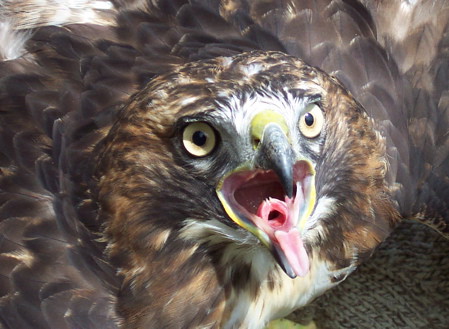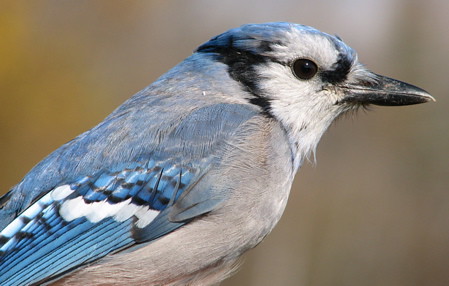I'm kind of bummed, I just got Frank's banding report for his hawk banding station for last weekend and the end of the report reminded all of us on the list that this coming weekend is the last weekend he will be banding--and I can't go! That means I will only have been to his place once this year. How did Autumn get away from me? This happened a little bit last fall.
Mental Note for 2007: Leave more time for Frank's banding station in the fall!
I shouldn't complain too much, the reason I can't go to Frank's this weekend is that I'm going to that legendary North American birding hot spot: Cape May Autumn Weekend.
Take a look at the red-tailed hawk photo at the top of this entry. That's a photo I took a couple of years ago at the station, but look at the pupils. Those are normal red-tailed hawk pupils. Now, take a look at the photo Frank took of a red-tailed hawk they got last weekend at the banding station:
Frank wrote, "We caught a passage (first year) Red-tail with both pupils slightly deformed. Chuck gave it the Doctor’s eye inspection and said he thought that both eyes were functioning properly." Chuck is a doctor and one of Frank's sub-banders. Even if the eyes weren't functioning properly, I'm not sure what could have been done. If the pupils are deformed, you can't really do a transplant and the bird would have to be put down. I wonder if the bird sees in double or if images are a little blurry? Can this bird find ways to hunt with this odd vision? It would have hatched at least six months ago and has been surviving and compensating somehow. So much discovered, and yet so many questions are left.
Besides the usual raptors, Frank also got in several passerines--without a bird feeder guiding them in, must be a good spot for birds passing through:
Here's a hairy woodpecker photo that Frank took.
Here's a blue jay photo from Frank. Blue jays are always hanging around the blind looking for left over pigeon chow. One year there was a blue jay that could mimic a broad-winged hawk. It was almost a perfect, except that the blue jay did it a little faster than an actual broad-wing...and you could hear the call well into October when we no longer have broad-winged hawks in Minnesota.
Here's an adult eastern bluebird that found its way into the nets as well. Isn't that just beautiful? I swear I have seen that exact same color scheme in a spring sunrise. Look at how the rust coloration works its way from the breast into the upper wing coverts and scapulars (shoulder feathers).





